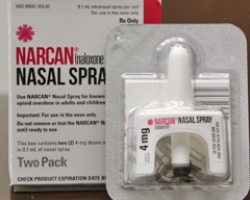A person is found unresponsive, possibly from an opioid overdose, and police officers are the first responders to the scene. Time matters in this potentially life-threatening situation as the person could stop breathing from the effects of the drugs.
This scene is playing out in towns nationwide amid a heroin and prescription opioid abuse epidemic that kills 115 Americans a day on average, according to the Centers for Disease Control and Prevention. And Seal Beach is not immune to the opioid crisis.
In a few weeks, Seal Beach Police officers will have a new tool to help in the crisis. Officers will be equipped with a prescription nasal spray that can block the effects of an opioid overdose. Sold under the name Narcan, the medicine is also known under its generic name, naloxone.
Seal Beach Police Department Sgt. Nick Nicholas, who is also an Emergency Medical Technician, is implementing the use of naloxone in the department. With naloxone, officers will be able to deliver life-saving aid once determining paramedics are on their way to the scene. “It’s great that we can start resuscitating the patient. Seconds count in those situations,” Sgt. Nicholas said in a recent interview. He said officers sometimes arrive on the scene of a medical emergency up to two minutes before the Orange County Fire Authority, depending on the location of the call.
According to Sgt. Nicholas, the patient could be revived in mere minutes. But it might take more than one dose of naloxone to fully reverse the effects of the opioid overdose. This is especially true if the patient has overdosed on a potent opioid such as fentanyl or carfentanyl. Any patient treated with naloxone will be transported to a hospital for further treatment.
All 33 sworn officers on the force will be trained to use naloxone and be given a kit containing two doses of the medicine along with gloves, a CPR mask and other items meant to protect the officer during the administration of the medicine.
It costs $75 for a box with two doses of the naloxone nasal spray. Sgt. Nicholas estimated the initial cost for the program would be between $2,500 to $3,000. The medicine is being paid for by the Seal Beach Police Department’s Asset Forfeiture Fund which is money the department gets from cash or property seized during drug investigations completed in partnership with the Drug Enforcement Agency.
The Orange County Health Care Agency provided training for the program. An employee at the agency trained Sgt. Nicholas and another officer on how to use naloxone and they will now train their fellow officers.
The Seal Beach Police Department is one of 15 law enforcement agencies in Orange County authorized to administer naloxone, according to Tammi McConnell, Emergency Medical Services Administrator with Orange County. The Orange County Sheriff’s Department started equipping deputies with the medicine in a 2015 pilot study and it was expanded the next year under a directive from the County’s Medical Director for Emergency Medical Services. Countywide, 64 patients have been saved from overdoses by law enforcement first responders equipped with naloxone as of last month.
‘We see overdoses fairly regularly’
So how often are officers responding to opioid emergencies in Seal Beach? “We see overdoses fairly regularly,” Sgt. Nicholas said. He personally responded to at least three heroin overdose calls in 2017. “It’s not necessarily a call that we get every night, somebody overdosing on heroin, which may happen in other, busier, cities, but it does happen.”
According to a report released by the OC Health Care Agency in August of 2017, Seal Beach had a total of 11 deaths from opioid overdoses from 2011-2015.
By comparison, Laguna Beach had 16, Newport Beach had 41 and Huntington Beach had 106 deaths from opioid overdoses during the same five-year period. Countywide, the average number of overdose deaths per year from 2011-2015 was 241.
For a broader look at opioid abuse, the report noted a 141 percent increase in the number of opioid-related visits to Orange County emergency departments from 2011-2015. Most of the visits, about 535 per year, were for opioid abuse or dependence. Forty-Nine Seal Beach residents went to the emergency department for an opioid-related issue from 2011-2015, according to the report. But Seal Beach also had the second highest rate for opioid prescriptions in the county in 2015, after Laguna Woods.
Sgt. Nicholas characterized opioid abuse in Seal Beach as “all over the place” and emphasized there is no stereotypical opioid user. “It ranges from a transient living along the riverbed to somebody living in a million-dollar home here in town,” he said.
But he’s hopeful that the use of naloxone by police officers will help, “Even if there’s only one overdose a year and we can save that one person’s life because our officers have Narcan, then the program works and it’s successful.”
How does Naloxone work?
Opioids include the illegal drug heroin but also prescription painkillers such as hydrocodone and oxycodone. Opioids are sedating and can be dangerous when taken in large amounts because they inhibit a person’s respiratory drive. This can cause someone to stop breathing. That’s where Narcan can help. The nasal atomizer releases naloxone into the blood which blocks opioid receptors in the brain thereby reducing the effects of the opioid. Naloxone has no effect if administered to someone who isn’t experiencing an opioid overdose, according to Sgt. Nicholas.
For more information on getting help with opioid abuse visit: www.ochealthinfo.com/opioids.




